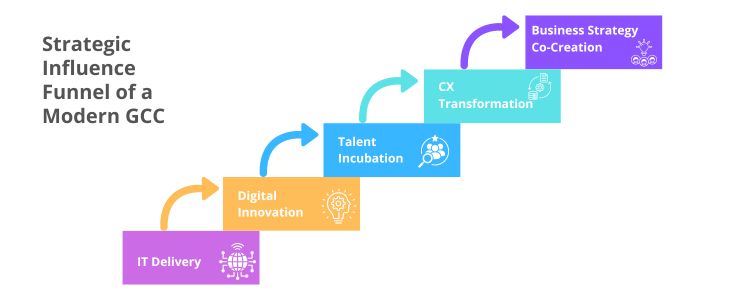
The global capability center (GCC) in India has come a long way—from optical distribution centers to becoming powerful centers of digital changes, innovation, and enterprise strategy. According to NASSCOM India will have over 1,900 active GCCs, which will contribute a revenue of $64.6 billion. Major global companies such as Amazon, Microsoft, JP Morgan, and Target have made their GCC notable expansion in India and have turned them into strategic commercial engines from operational aid centers. India’s rise as the GCC Strategy Centre is powered by three major pillars: As businesses are facing new demands like AI, customer personalisation, and stability mandates, the GCC of India is now at the center of boardroom decisions. Let’s understand how they can make this jump.
In the early 2000s, the GCC in India mainly served as an offshore delivery center (ODC). They used to do regular IT, finance, and human resources functions under the stringent SLA. Their role was limited to backend efficiency, not enterprise changes. As of 2010, there were more than 750 GCCs in India, most of which were seen as supporting teams, which were different from corporate decision-making. They were not part of development or innovation discussions.
The story began to change during the wave of adoption of the cloud, and the epidemic intensified it. Companies began to depend on their India-based GCC for data science, customer insight, product experiments, and even cyber security. By 2023: GCC Role Table:
GCC now actively includes the following: According to a 2024 report, India will host more than 2,400 GCCs by 2030, which will generate more than $100 billion. Many global CXOs now see their Indian GCC not only as an ODC, but as an important expansion of the headquarters.
India’s value proposal is no longer just the cost; it is capacity, continuity, and co-construction.
Modern GCC now in India: This strategic advancement is possible due to the following reasons: India’s GCC ecosystem is no longer just the only distribution support model. It is a value creation model.
The future of GCC in India lies not only in functional distribution but also in commercial ownership. We believe that GCC will play a leading role in the following sectors: Policies and new GCC-specific SEZ reforms like India’s DPI (Digital Public Infrastructure) establish it as the best geographical area to prepare your enterprise for the future.
In less than two decades, the GCC in India has redefined its role: from IT engine to strategic business competence. Their development reflects India’s rise in the global digital economy. With the right strategy, leadership, and advisory assistance, your GCC can become the command center of not only a back-end office but also a global development. Changes from ODC to the Orchestration Centre are not only possible, but they are already happening.
As Inductus GCC as a leading GCC enabler and strategy partner in India, provides the following assistance to global enterprises:
An ODC is usually focused on software development and distribution, while GCC handles extensive business capabilities, including strategy, customer experience, product design, and digital innovation. India offers cost efficiency (savings up to 70%), world-class digital talent, a strong startup ecosystem, and a unique mix of favourable government policies. These factors make India a global leader in the GCC setup. Initially seen as back-end support or cost centers, today’s GCC enterprise strategy includes AI governance, product innovation, and customer experience management. Now they are boardroom-level assets. GCC has a wide range of applications in banking and financing services, retailing, healthcare, telecommunications, and manufacturing and technology sectors. The dominant front in scale and innovation maturity is the BFSI and technical sectors. The Government of India supports the expansion of GCC through Digital Public Infrastructure (DPI), Special Economic Sector (SEZ) reforms, favourable taxation, and business-facilitating policies, making it attractive to long-term strategic investments. Aditi, with a strong background in forensic science and biotechnology, brings an innovative scientific perspective to her work. Her expertise spans research, analytics, and strategic advisory in consulting and GCC environments. She has published numerous research papers and articles. A versatile writer in both technical and creative domains, Aditi excels at translating complex subjects into compelling insights. Which she aligns seamlessly with consulting, advisory domain, and GCC operations. Her ability to bridge science, business, and storytelling positions her as a strategic thinker who can drive data-informed decision-making.
Once Just the Help Desk (2000-2010)
Shifting from Innovation to Efficiency
Function
Traditional GCC (2010)
Modern GCC in India (2025)
IT Operations
Ticket Handling
AI Ops Architecture
Finance
Invoice Processing
Treasury & Forecasting
HR
Payroll & Admin
Workforce Analytics
Product Dev.
Code Execution
Co-Design & Customer Insights
CX Support
Helpdesk Services
Omnichannel Experience Design
Cost Centre to Capability Centre

Boardroom Effect (GCC on CEO's Table)
Strategy to Sovereignty
Conclusion
frequently asked questions (FAQs)

Aditi
Hey, like this? Why not share it with a buddy?
Related Posts
Recent Blog / Post
- The Legal and Compliance Checklist for a New GCC Setup October 4, 2025
- The Rise of Niche GCCs: A Focus on Specialised Capabilities October 4, 2025
- The Impact of Regulatory Changes on GCC Operations October 4, 2025
- Cybersecurity for GCCs: A Proactive Approach to Data Protection September 30, 2025
- Beyond Cost: Measuring the True ROI of Your GCC Investment September 29, 2025
- The Future of GCCs in the Retail Sector: A Strategic Playbook September 29, 2025
- David vs Goliath: Mid-Sized GCCs Quietly Outperform the Big Brands September 29, 2025
- Infineon’s Big Bet on India: Inside Its First GCC in GIFT City September 29, 2025
- From Campuses to Capability Centres: How Indian Universities Power the Global GCC Ecosystem September 29, 2025
- Retail Meets Digital: Costco’s GCC in Hyderabad Marks a Global Shift September 29, 2025
- The Silent Crisis: Why Many GCCs Plateau After 3 Years and How to Avoid It September 24, 2025
- Germany’s New Skilled Immigration Act and Its Ripple Effect on the GCC Talent Model September 24, 2025
- From Tokyo to Hyderabad: The Future of GCCs for Japanese Conglomerates September 23, 2025
- GCCs as AI Acceleration Hubs: Collaborating with US and Nordic Tech Majors September 19, 2025
- Breaking the Tech Ceiling: How Women Leaders Are Reshaping India’s GCC Landscape September 19, 2025
















